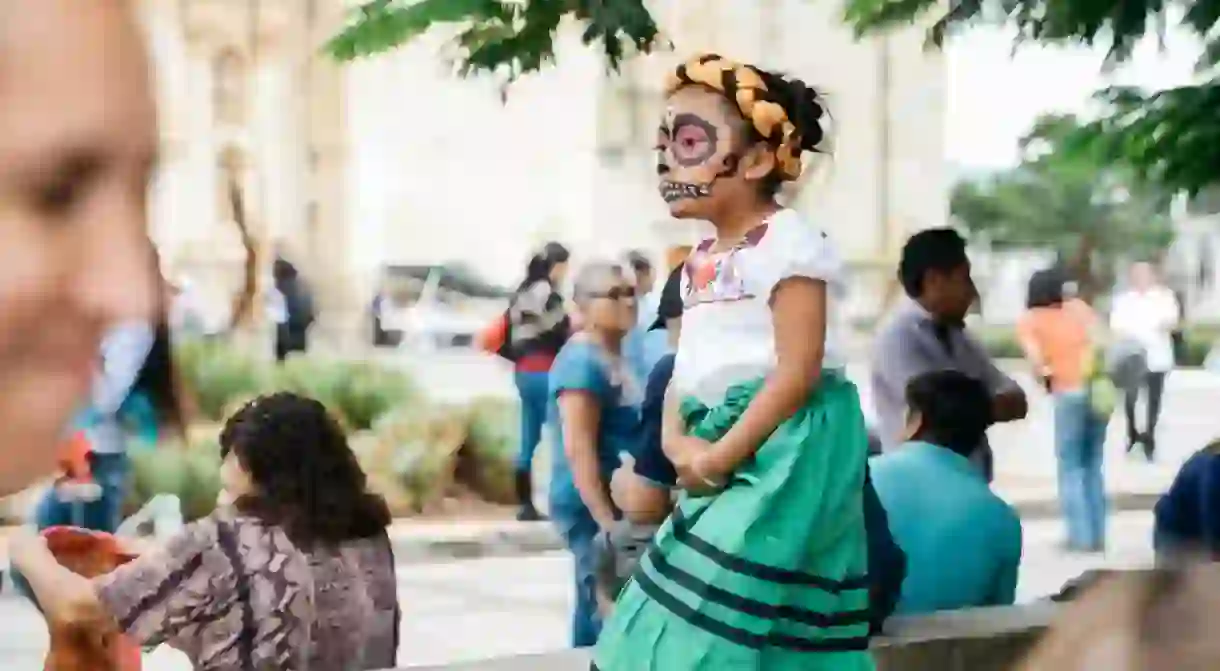How Locals Celebrate Day of the Dead in Oaxaca

Day of the Dead is one of Mexico’s most magical holidays. It’s a time when family and friends come together to remember their dead loved ones through food, music, prayer and colorful altars. Oaxaca, Mexico’s southern cultural gem, is a unique place to experience Dia de Muertos. If you go to Oaxaca for this hauntingly beautiful celebration, there are a few stops you must make.
Markets
An obligatory stop for anyone that wants a full grasp on this holiday is a local market. While Mexican markets are always a jumble of color, sight and sound, Day of the Dead means everyday markets will be bursting with the orange of cempasúchil flowers, the purple of Celosia buds and the powdery white of baby’s breath blooms.




These are special flowers that help guide the dead back to the living during the nights of the Dia de Muerto holiday (October 31 to November 2). The flowers are arranged on gravestones, gathered around home altars and their petals scattered in entryways to guide loved ones to the right place.

Other important items on the shopping list are sugar skulls, pan de muerto, tissue papel flags and tiny plates of favorite “food” made with marzipan and frosting. The 20 de Noviembre market or the main central de abastos market in Oaxaca City are both great places to experience the first step in preparation for the holiday – purchasing flowers. In addition, any small town you visit will have its own market or street fair selling similar items. The Friday market in Ocotlan is another great choice for experiencing the tradition.

Fiesta
Oaxaca is known for its parties and calenda – a type of street party that includes massive puppets on stilts, costumed dancers, music and fireworks. Throughout the holiday, streetside stands are set up in downtown Oaxaca City to paint the faces of the young and old, who head out in costume each night to celebrate.




Street processions and parties are held in various neighborhoods throughout Oaxaca City and through the main downtown streets. The nearby town of Etla has a very special and famous calenda that tour companies can arrange to take you to, if you’re unsure about visiting on your own.




Kids “trick or treat” on both October 31 of Halloween and November 1 for Day of the Dead. They usually carry a small pumpkin in which to collect their candy, and will sing a little song in order to cajole candy from the locals. Instead of door to door, kids often go business to business, singing to street vendors and pharmacists. Many head to home altars on November 2 with their families where hosts will often hand out candy too.


Cemeteries
One of the most important elements of Dia de Muertos is the tradition of decorating the family gravestone. During the day of November 2 families go out together and clean up the gravestones of their family members. They bring flowers to arrange, candles to light and sometimes even play the favorite music of their dead relatives.



Groups of families and friends stay late to drink, eat, laugh and tell stories of those who are gone. In Oaxaca City, visit the Panteon San Miguel to see graves lit up with candles, and families honoring their relatives with flowers, music and prayer. Flowers are arranged in the shape of a cross or heart, with petals often leading the way to each grave from the cemetery’s main avenues.


The nearby town of Xoxocotlan, just outside of Oaxaca City, has two cemeteries, the Panteon Viejo (old cemetery) and the Panteon Nuevo (new cemetery). These are often visited by both tourists and locals, so you’re unlikely to feel out of place. Here you will find hundreds of decorated graves lit with an orange glow from the many candles adorning them.


There are also general ofrendas or altars set up around the streets of each town and village. Take the time to wander through the city center and you will come across sand mosaics and home altars, as well as those created by businesses, the local government and schools. Locals are usually more than happen to welcome you in to sit and drink some ponche – a hot, spiced tea common during this time of year.


Wherever you decide to visit always be respectful of the deeply held traditions that make this celebration special. Take what is offered to you, do your best to interact politely with people and always ask to take photos in advance. This is a time of celebration so most of the people you come across will want to speak about their loved ones – give them the opportunity to honor them by telling you their story.













